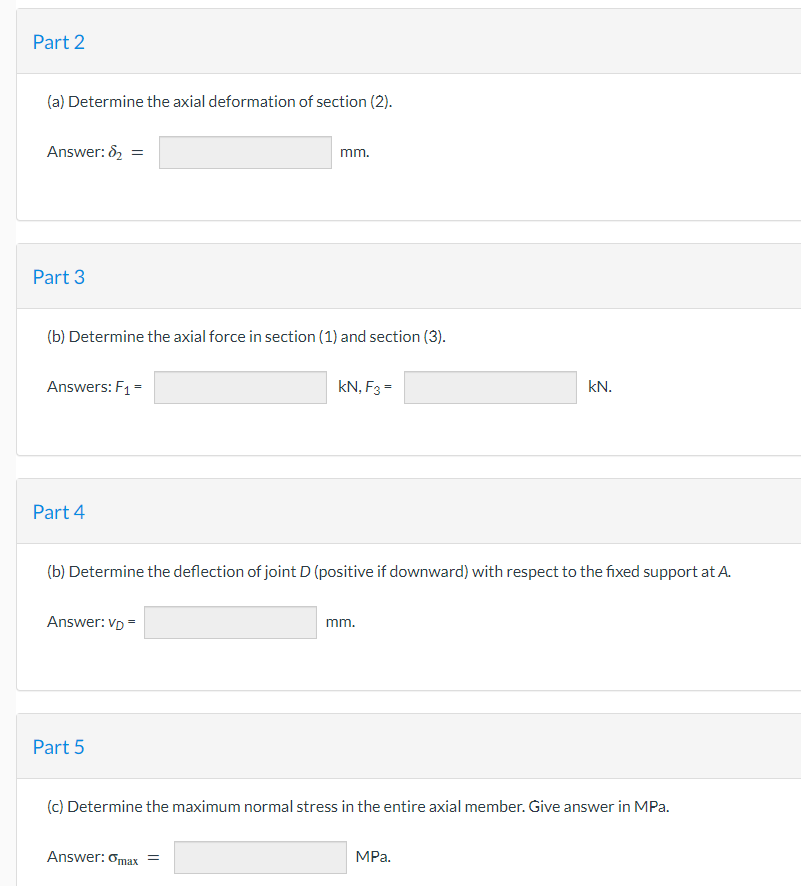A solid brass [E-99 GPa) axial member is loaded and supported as shown. Segments (1) and (2) each have a diameter of 20 mm and segment (3) has a diameter of 11 mm. Assume L₁ - 1.6 m, L₂-1.0 m, L3-1.6 m, R-36 kN, Q-14 kN, and 28 kN. Determine: (a) the deformation of segment (2). (b) the deflection of joint D with respect to the fixed support at A. (c) the maximum normal stress in the entire axial member. 4₁ L₂ Ly (3) (1) A (2) B C
A solid brass [E-99 GPa) axial member is loaded and supported as shown. Segments (1) and (2) each have a diameter of 20 mm and segment (3) has a diameter of 11 mm. Assume L₁ - 1.6 m, L₂-1.0 m, L3-1.6 m, R-36 kN, Q-14 kN, and 28 kN. Determine: (a) the deformation of segment (2). (b) the deflection of joint D with respect to the fixed support at A. (c) the maximum normal stress in the entire axial member. 4₁ L₂ Ly (3) (1) A (2) B C
Elements Of Electromagnetics
7th Edition
ISBN:9780190698614
Author:Sadiku, Matthew N. O.
Publisher:Sadiku, Matthew N. O.
ChapterMA: Math Assessment
Section: Chapter Questions
Problem 1.1MA
Related questions
Question

Transcribed Image Text:Part 2
(a) Determine the axial deformation of section (2).
Answer: 8₂ =
Part 3
(b) Determine the axial force in section (1) and section (3).
Answers: F₁ =
Part 4
Answer: VD-
mm.
Part 5
(b) Determine the deflection of joint D (positive if downward) with respect to the fixed support at A.
kN, F3 =
Answer: Omax =
mm.
kN.
(c) Determine the maximum normal stress in the entire axial member. Give answer in MPa.
MPa.
![A solid brass [E = 99 GPa] axial member is loaded and supported as shown. Segments (1) and (2) each have a diameter of 20 mm and segment (3) has a diameter of 11 mm. Assume L₁ = 1.6 m, L₂=1.0 m, L3= 1.6 m, R = 36 kN, Q = 14 kN, and P =
28 kN. Determine:
(a) the deformation of segment (2).
(b) the deflection of joint D with respect to the fixed support at A.
(c) the maximum normal stress in the entire axial member.
L₁
L2
L3
(3)
Answer: F₂ =
(1)
D
B
C
(a) Determine the axial force in section (2) in kN.
kN.](/v2/_next/image?url=https%3A%2F%2Fcontent.bartleby.com%2Fqna-images%2Fquestion%2Fbbb16848-0151-4811-b617-402fad34b898%2F5692a38e-c078-4869-9a6f-d7d9ce41d6f9%2Fkzcaz5k_processed.png&w=3840&q=75)
Transcribed Image Text:A solid brass [E = 99 GPa] axial member is loaded and supported as shown. Segments (1) and (2) each have a diameter of 20 mm and segment (3) has a diameter of 11 mm. Assume L₁ = 1.6 m, L₂=1.0 m, L3= 1.6 m, R = 36 kN, Q = 14 kN, and P =
28 kN. Determine:
(a) the deformation of segment (2).
(b) the deflection of joint D with respect to the fixed support at A.
(c) the maximum normal stress in the entire axial member.
L₁
L2
L3
(3)
Answer: F₂ =
(1)
D
B
C
(a) Determine the axial force in section (2) in kN.
kN.
Expert Solution
This question has been solved!
Explore an expertly crafted, step-by-step solution for a thorough understanding of key concepts.
Step by step
Solved in 2 steps

Knowledge Booster
Learn more about
Need a deep-dive on the concept behind this application? Look no further. Learn more about this topic, mechanical-engineering and related others by exploring similar questions and additional content below.Recommended textbooks for you

Elements Of Electromagnetics
Mechanical Engineering
ISBN:
9780190698614
Author:
Sadiku, Matthew N. O.
Publisher:
Oxford University Press

Mechanics of Materials (10th Edition)
Mechanical Engineering
ISBN:
9780134319650
Author:
Russell C. Hibbeler
Publisher:
PEARSON

Thermodynamics: An Engineering Approach
Mechanical Engineering
ISBN:
9781259822674
Author:
Yunus A. Cengel Dr., Michael A. Boles
Publisher:
McGraw-Hill Education

Elements Of Electromagnetics
Mechanical Engineering
ISBN:
9780190698614
Author:
Sadiku, Matthew N. O.
Publisher:
Oxford University Press

Mechanics of Materials (10th Edition)
Mechanical Engineering
ISBN:
9780134319650
Author:
Russell C. Hibbeler
Publisher:
PEARSON

Thermodynamics: An Engineering Approach
Mechanical Engineering
ISBN:
9781259822674
Author:
Yunus A. Cengel Dr., Michael A. Boles
Publisher:
McGraw-Hill Education

Control Systems Engineering
Mechanical Engineering
ISBN:
9781118170519
Author:
Norman S. Nise
Publisher:
WILEY

Mechanics of Materials (MindTap Course List)
Mechanical Engineering
ISBN:
9781337093347
Author:
Barry J. Goodno, James M. Gere
Publisher:
Cengage Learning

Engineering Mechanics: Statics
Mechanical Engineering
ISBN:
9781118807330
Author:
James L. Meriam, L. G. Kraige, J. N. Bolton
Publisher:
WILEY